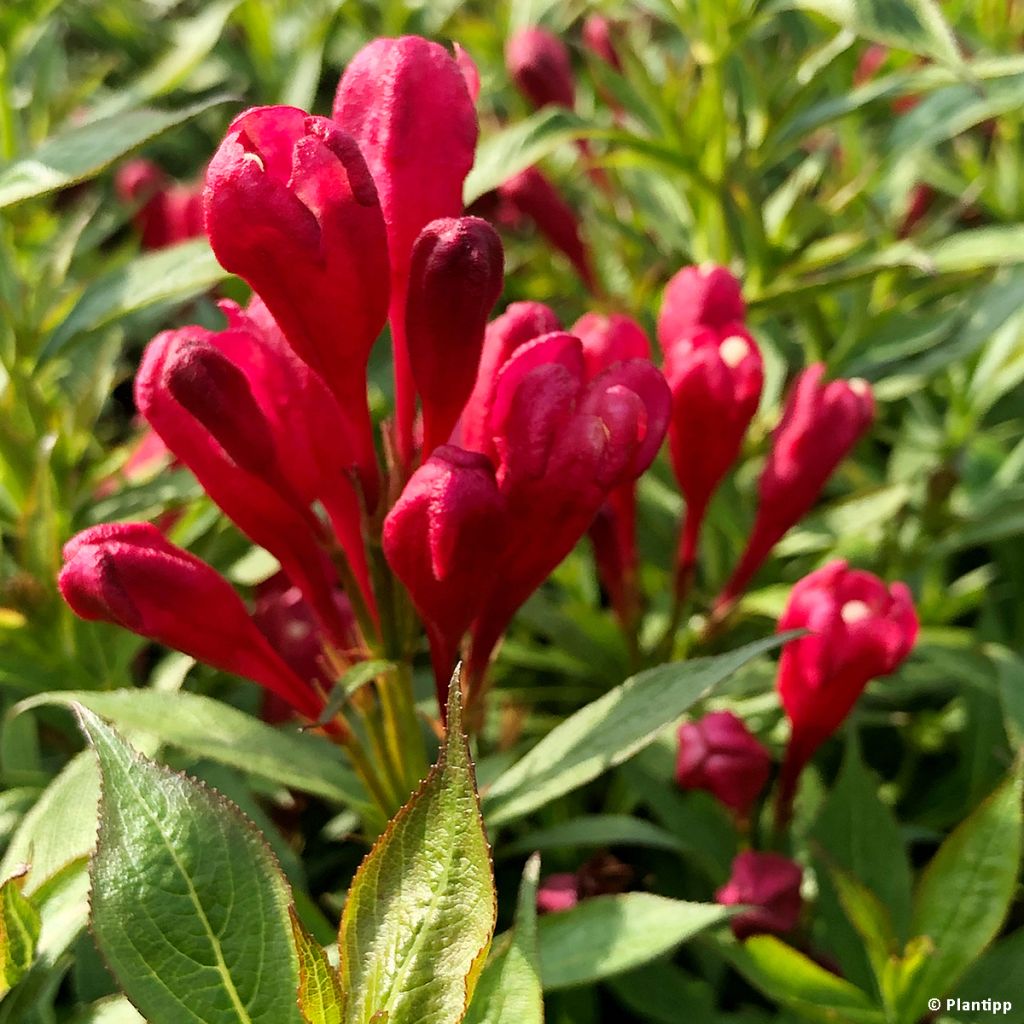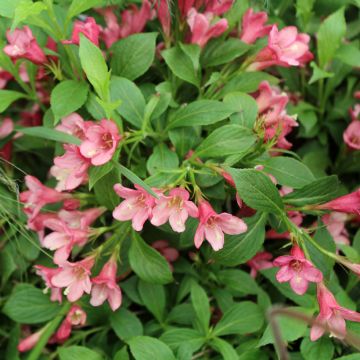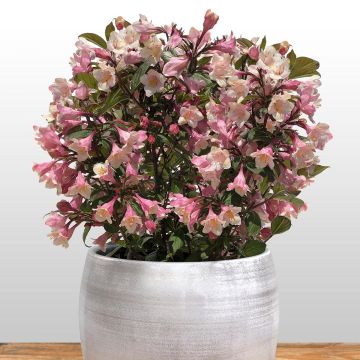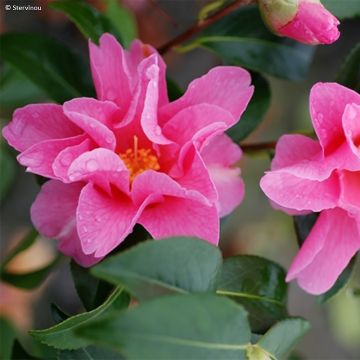

Weigela florida Picobella Rosso


Weigela florida Picobella Rosso


Weigela florida Picobella Rosso


Weigela florida Picobella Rosso


Weigela florida Picobella Rosso
Weigela florida Picobella Rosso
Weigela x florida Picobella Rosso® 'TVP3'
Old-fashioned Weigela
This item cannot be shipped to the selected country
Delivery charge from €5.90
More information
Schedule delivery date,
and select date in basket
This plant carries a 24 months recovery warranty
More information
We guarantee the quality of our plants for a full growing cycle, and will replace at our expense any plant that fails to recover under normal climatic and planting conditions.
From €5.90 for pickup delivery and €6.90 for home delivery
Express home delivery from €8.90.
Does this plant fit my garden?
Set up your Plantfit profile →
Description
The Picobella Rosso Weigela is undoubtedly one of the best recent varieties of this shrub that is so widespread in our gardens. It has a very compact habit, suitable for growing in containers on a balcony or terrace, as well as in borders in the garden. Above all, its flowering is particularly long-lasting and abundant, with a bright red colour, as it lasts from May to October with just a slight lull in August. Its fine foliage, a bright green, beautifully enhances its pretty bell-shaped flowers. Like other Weigelas, this plant is easy to grow in ordinary, moist but well-drained soil. It is very hardy and adaptable, making it suitable for all gardens.
The Picobella Rosso Weigela is derived, among others, from W. florida, native to northeastern China, Korea, and Japan. The Weigela genus includes about ten Asian species and belongs to the Caprifoliaceae family, which comprises more than 400 species, including many ornamental plants. It is in fact the same family as honeysuckles (Lonicera), Abelia, Leycesteria, or Heptacodium, to name just a few well-known examples. Weigela florida, which in nature forms a 3 m (10 ft) tall shrub with pink flowers, was introduced to Europe in the mid-19th century. The famous Lorraine nurseryman Victor Lemoine hybridised this genus extensively to introduce new varieties, just as he did with lilacs and many other ornamental plants.
This new cultivar was selected by horticulturist Bert Verhoef in his nursery in Hazerswoude-Dorp, north of The Hague, in the Netherlands. 'Picobella Rosso' has an exceptionally compact growth. Its vegetation is naturally compact, forming a spread cushion of about 40 to 50 cm (16 to 20 in) in height and 80 to 100 cm (32 to 39 in) in width at maturity. The foliage of this variety is deciduous and medium green in colour. It consists of fine, lanceolate, slightly undulate leaves that provide an attractive backdrop for its magnificent flowering. The funnel-shaped flowers are produced abundantly from May to October, with a slight summer break in August. They are a rich and vivid red, arranged in corymbs at the tips of the previous year's branches. This flowering is highly melliferous and nectar-rich, renewing itself from spring to autumn without the need to remove faded flowers, as they disappear naturally. Hardy down to -25 °C (-13 °F), the 'Picobella Rosso' Weigela thrives in sunny or semi-shaded positions, in moist but well-drained soil. Its tolerance to various pH levels is highly appreciated, as it can withstand slightly acidic, neutral, or alkaline soils, making it very adaptable. A robust plant, it requires no maintenance or pruning. At most, you may lightly trim it after the first spring flowering if you wish to limit its already compact size, but this is absolutely not necessary!
With its endless flowering and compact habit, this small Weigela will be perfect as a border plant, combined with slightly taller shrubs in the background. To stay within a range of easy plants, opt for the classic Bridal Wreath Spirea, a 2 m (7 ft) tall shrub that is covered in white flowers from April to June. Equally easy to grow, Butterfly Bushes will also be good companions, offering a wide range of flower colours, from blue to purple, white, lavender, or even yellow, on green, grey, or variegated foliage. There is also plenty of generosity among the Crape Myrtles, or Indian Lilacs, which enchant with their magical summer blooms. With a similar size to Picobella Rosso, the essential Shrubby Cinquefoils can accompany it at the forefront of your summer border.
Report an error about the product description
Weigela florida Picobella Rosso in pictures






Plant habit
Flowering
Foliage
Botanical data
Weigela
x florida
Picobella Rosso® 'TVP3'
Caprifoliaceae
Old-fashioned Weigela
Cultivar or hybrid
Other Weigela
Planting and care
Hardy down to -25 °C (-13 °F), Weigela 'Picobella Rosso' thrives in sunny or semi-shaded situations. Plant it in a moist but well-drained ordinary soil, preferably in autumn to allow it to establish itself well before summer, or possibly in spring. This shrub is very accommodating and accepts slightly acidic, neutral, or even slightly alkaline soils. Dig a hole 50 cm (20 in) in all directions and add some planting compost by mixing it with the existing soil. Soak the root ball of your Weigela in a bucket of water for fifteen minutes before planting it in the hole. Fill in and water generously. Water regularly during the first year, and then in hot periods in the following years.
With its compact size, this shrub is also particularly suitable for container planting. Choose a terracotta or "double-skinned" plastic container (with an insulating layer of air) to prevent the roots from heating up in the sun, and water regularly.
Planting period
Intended location
Care
This item has not been reviewed yet - be the first to leave a review about it.
Spring-flowering shrubs
Haven't found what you were looking for?
Hardiness is the lowest winter temperature a plant can endure without suffering serious damage or even dying. However, hardiness is affected by location (a sheltered area, such as a patio), protection (winter cover) and soil type (hardiness is improved by well-drained soil).

Photo Sharing Terms & Conditions
In order to encourage gardeners to interact and share their experiences, Promesse de fleurs offers various media enabling content to be uploaded onto its Site - in particular via the ‘Photo sharing’ module.
The User agrees to refrain from:
- Posting any content that is illegal, prejudicial, insulting, racist, inciteful to hatred, revisionist, contrary to public decency, that infringes on privacy or on the privacy rights of third parties, in particular the publicity rights of persons and goods, intellectual property rights, or the right to privacy.
- Submitting content on behalf of a third party;
- Impersonate the identity of a third party and/or publish any personal information about a third party;
In general, the User undertakes to refrain from any unethical behaviour.
All Content (in particular text, comments, files, images, photos, videos, creative works, etc.), which may be subject to property or intellectual property rights, image or other private rights, shall remain the property of the User, subject to the limited rights granted by the terms of the licence granted by Promesse de fleurs as stated below. Users are at liberty to publish or not to publish such Content on the Site, notably via the ‘Photo Sharing’ facility, and accept that this Content shall be made public and freely accessible, notably on the Internet.
Users further acknowledge, undertake to have ,and guarantee that they hold all necessary rights and permissions to publish such material on the Site, in particular with regard to the legislation in force pertaining to any privacy, property, intellectual property, image, or contractual rights, or rights of any other nature. By publishing such Content on the Site, Users acknowledge accepting full liability as publishers of the Content within the meaning of the law, and grant Promesse de fleurs, free of charge, an inclusive, worldwide licence for the said Content for the entire duration of its publication, including all reproduction, representation, up/downloading, displaying, performing, transmission, and storage rights.
Users also grant permission for their name to be linked to the Content and accept that this link may not always be made available.
By engaging in posting material, Users consent to their Content becoming automatically accessible on the Internet, in particular on other sites and/or blogs and/or web pages of the Promesse de fleurs site, including in particular social pages and the Promesse de fleurs catalogue.
Users may secure the removal of entrusted content free of charge by issuing a simple request via our contact form.
The flowering period indicated on our website applies to countries and regions located in USDA zone 8 (France, the United Kingdom, Ireland, the Netherlands, etc.)
It will vary according to where you live:
- In zones 9 to 10 (Italy, Spain, Greece, etc.), flowering will occur about 2 to 4 weeks earlier.
- In zones 6 to 7 (Germany, Poland, Slovenia, and lower mountainous regions), flowering will be delayed by 2 to 3 weeks.
- In zone 5 (Central Europe, Scandinavia), blooming will be delayed by 3 to 5 weeks.
In temperate climates, pruning of spring-flowering shrubs (forsythia, spireas, etc.) should be done just after flowering.
Pruning of summer-flowering shrubs (Indian Lilac, Perovskia, etc.) can be done in winter or spring.
In cold regions as well as with frost-sensitive plants, avoid pruning too early when severe frosts may still occur.
The planting period indicated on our website applies to countries and regions located in USDA zone 8 (France, United Kingdom, Ireland, Netherlands).
It will vary according to where you live:
- In Mediterranean zones (Marseille, Madrid, Milan, etc.), autumn and winter are the best planting periods.
- In continental zones (Strasbourg, Munich, Vienna, etc.), delay planting by 2 to 3 weeks in spring and bring it forward by 2 to 4 weeks in autumn.
- In mountainous regions (the Alps, Pyrenees, Carpathians, etc.), it is best to plant in late spring (May-June) or late summer (August-September).
The harvesting period indicated on our website applies to countries and regions in USDA zone 8 (France, England, Ireland, the Netherlands).
In colder areas (Scandinavia, Poland, Austria...) fruit and vegetable harvests are likely to be delayed by 3-4 weeks.
In warmer areas (Italy, Spain, Greece, etc.), harvesting will probably take place earlier, depending on weather conditions.
The sowing periods indicated on our website apply to countries and regions within USDA Zone 8 (France, UK, Ireland, Netherlands).
In colder areas (Scandinavia, Poland, Austria...), delay any outdoor sowing by 3-4 weeks, or sow under glass.
In warmer climes (Italy, Spain, Greece, etc.), bring outdoor sowing forward by a few weeks.























































